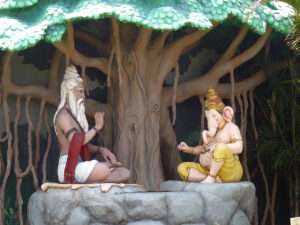After undergoing severe penances and prolonged meditations, the sage Vyasa, who throughout his life had always kept faith in his vows and observed the practices of spiritual ascents, studied with great attention and seriousness the eternal knowledge contained in the Vedas, texts which at that time had not yet been written down, but were only repeated in oral form. Aware of the difficulties that most of the people, who were generally not prone to analytical reasoning, would encounter, he tried to tell in a simple and clear way the philosophical concepts expressed in it.
Meanwhile, the events that the Rishi was about to narrate were in full swing, and the presence of Sri Krishna on the planet gave him the right inspiration to outline the fundamental principles of spirituality in his mammoth work. And in his mind as vast and deep as the ocean, the story that he would later call Maha-bharata took shape, with all its delicate forms of expression and its divine concepts enclosed in the pressing of events.
Several years had passed since the day the sage began to meditate and recall the Maha-bharata in his mind, and when he finally finished it, he thought it appropriate to put it in writing so that it could be spread among the peoples. In those days, the Deva Ganesha came to his aid and was happy to accept the post of scribe. Soon the whole work became a wonderful reality. The Maha-bharata was divided into 18 Parvas with 1,929 sections, with an approximate total of 100,000 verses.
Three years passed before the whole job was done.
“Know, oh, wise men with hearts totally free from the terrible defilements of lust and anger, that in this world never had been written down such a sublime work. Listen carefully as I recite it.”
This is a section of the book “Maha-bharata, Vol. 1”.
To buy the complete book, click above
Post view 419 times




Leave a Reply